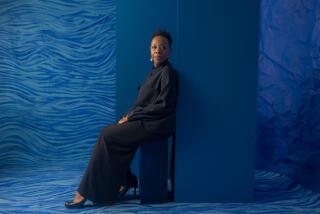From one scene . . .
- Share via
Diane Baker’s professional acting career began by her performing a scene from the 1955 James Dean movie “East of Eden.”
“I did the scene for three studios,” says the vivacious 71-year-old. “That’s all I ever did. I never went on an audition. I got offered contracts with CBS, Paramount and Fox. My agent came to me and said, ‘You got offers from all three. Let’s pick the best one.’ It turned out to be Fox.”
Baker, who is celebrating her 50th year as an actress, has appeared in such classic films as “The Diary of Anne Frank,” “Marnie” and the Oscar-winning best film “The Silence of the Lambs.” She’s also a documentary filmmaker (“Ashiana”) and TV producer (“A Woman of Substance”).
For the last five years, Baker has been at the Academy of Art University in San Francisco, first as the director of acting and then as executive director of its Motion Pictures & Television and Acting School.
Now she’s contemplating leaving her post to return full time to L.A. to produce, act and direct. She also recently received an offer to become executive director of the Documentary Film Foundation.
Come Friday, she’ll be appearing at the American Cinematheque’s tribute to her at the Egyptian Theatre in Hollywood. There will be a screening of the 1964 William Castle thriller, “Strait-Jacket,” in which she plays the daughter of a hatchet murderess (Joan Crawford), and the 1965 thriller “Mirage,” with Gregory Peck.
Baker first worked with the legendary Crawford, three decades her senior, in the 1959 glossy soap opera “The Best of Everything.” “She was something else,” recalls Baker, relaxing in the sun-drenched living room of her pink Hollywood Hills home. “My God, what a character.”
During the filming of “Best,” though, Baker felt sorry for the actress because her husband, Pepsi-Cola executive Alfred Steele, had recently died. “I saw her several times sitting there crying waiting for her shot,” she says.
“I remember getting a box of Kleenex and bringing it to her. I remember for some reason that connected with her.”
But Crawford was also tough on her -- “not yelling so much as bossy,” says Baker. But the younger woman didn’t kowtow to Crawford, who had won an Oscar for 1945’s “Mildred Pierce.” “She would have someone come and say, ‘Miss Crawford would like to see you in her dressing room.’ I would say, basically, ‘Excuse me. I am in the middle of a meeting or talking to my acting teacher who is on the set. I will come when I can.’ ”
Her attitude and talent impressed Crawford. “Hedda Hopper said Crawford would say nice things about me. Years later, a fan wrote me a letter from London and sent me a little note he got from Joan saying she was working with a young newcomer in Hollywood who was very talented.”
Baker recalls that Crawford was very “picky” on “Strait-Jacket,” to the point she would have someone on the set taking pictures with a Polaroid.
“If there was something wrong with the way I looked or the makeup wasn’t right, she would show these shots to wardrobe people and say, ‘You have to fix it.’ It wasn’t easy to sit down and have conversations with her. You didn’t have conversations.”
But she did with Peck. “I loved Gregory Peck,” she says. “He was sensitive and had a great sense of humor, and his jokes were so innocent and innocuous but wonderfully warm. You couldn’t help but feel like you were being really protected. And he listened, which is an art that doesn’t exist anymore.”
“Mirage” was the second film she made at Universal after finishing her contract with Fox. The first was Alfred Hitchcock’s 1964 thriller, “Marnie,” in which she played Sean Connery’s sister-in-law.
“Marnie” was the final film he made with Tippi Hedren, whom he introduced to audiences in 1963’s “The Birds.” Hedren was the latest in the line of “Hitchcock blonds,” following the likes of Grace Kelly and Eva Marie Saint.
“He was ending his contract with Tippi and he was looking for someone new, and that was me,” Baker says.
“When I first met the man and his wife in his home, his wife pulled out photographs in a magazine of Grace Kelly to show how we could have a similarity of looking. I thought my mother looked more like Grace Kelly than me. All the way through the production he was trying to make a connection to me.”
Then there was his drinking. “Don’t even go there,” says Baker. “He was at lunch drinking wine. He got red and fat and unhappy, miserable. He was angry at Tippi, and you could feel the anger. One day he was talking to me about Tippi and I said, ‘Mr. Hitchcock, I just wonder what you say behind my back when I’m not here?’ And he said, ‘I would never say anything about you or against you because I love you.’ ”
He kept Baker on the production until the very last day of filming. “He didn’t want to let me out of there,” she says. “They said you can’t just leave . . . there is no stop date for you on a Hitchcock movie.”
For more information on the tribute, go to www.americancinematheque.com.
Elsewhere
The Egyptian is presenting two otherworldly romances Thursday evening: 1948’s exquisite “Portrait of Jennie,” with Joseph Cotten and Jennifer Jones, and the lovely 1947 fantasy “The Ghost and Mrs. Muir,” starring Gene Tierney, Rex Harrison and a young Natalie Wood.
--
More to Read
Only good movies
Get the Indie Focus newsletter, Mark Olsen's weekly guide to the world of cinema.
You may occasionally receive promotional content from the Los Angeles Times.











